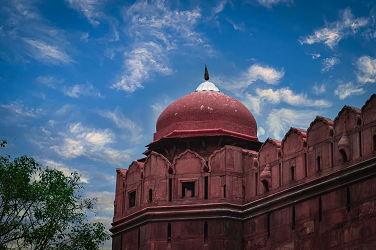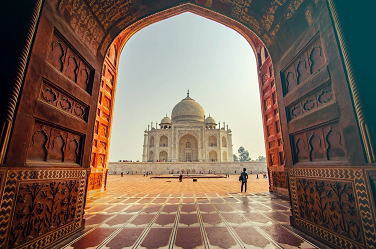
Delhi, a city
where one can easily witness a lovely fusion of ancient and modern
architecture. In one moment, all you can hear is the honking of cars but, at
another moment, you can find solace by visiting sacred places of the city. Want
to buy Indian clothes at a reasonable price? The city is known for markets like
Chandni Chowk. Also known as "Dill
Waalon Ki Delli" is also home to the well-organised and sophisticated
Connaught Place.
Enough talking;
let's tell you about the locations that will make you envy Delhiite.
1.
India Gate
War Memorial
One can easily locate the 42 m high India Gate standing in
the middle of the crossroad. The All India War Memorial also referred to as the
India Gate, is a memorial created to honour the martyred Indian soldiers who
fought for the British Army in World War I. The sandstone arch is situated on
the Rajpath's eastern section. The memorial displays the names of more than 13,516 British and Indian
soldiers killed in the Northwestern Frontier in the Afghan War of 1919.
The design by Sir Edward Lutyens is comparable to the Arch of Constantine.
It presently has a monument made of black marble to honour
the troops who gave their lives during the 1971 Bangladesh Liberation War. The
name of this is Amar Jyoti Jawan.
2.
Humayun Tomb
Humayun’s resting place
The Humayun tomb is the first monument constructed in India
to have a Mughal architectural style. It was constructed by Akbar in the 1570s,
setting an example for the future. As the name suggests, it is the final
resting place of Humayun, the second Mughal emperor. The garden tomb was
constructed by Persian and Indian craftsmen and is far larger than any other
tomb ever constructed in the Islamic world. Mirak Mirza Ghiyath was the main
architect. The structure has a charbagh (is a four-quadrant garden) with pools
connected by canals, representing the four rivers of the Quranic paradise.
Pavilions are positioned in the middle of the eastern and northern walls, and
the garden is accessed from lofty gateways on the south and the west.
It is one of the most popular attractions in Delhi and is
listed as a UNESCO cultural heritage monument.
3.
Red Fort
The
construction was initiated in 1526 AD by the first Mughal Emperor but it was
later refined by Shah Jahan with a fusion of various traditions: Islamic,
Persian, Timurid and Hindu. The fort was built as Shahjahanabad – the new
capital of Shah Jahan, the fifth Mughal
Emperor of India. The monument is situated in Old Delhi one can see River
Yamuna surrounding the strong walls of the fort.
The
National Traveller Magazine considers this monument to be one of the top fifty
destinations on the planet that a person must see. One can also find artefacts,
paintings, daggers, drapes, and other items belonging to the Mughal era in the
fort's museum.
4.
Akshardham Temple
Dr APJ
Abdul Kalam completed the building of this magnificent structure on November 6,
2005. The structure was built in a period of five years with the efforts of
11,000 artisans. The structure was built in honour of Bhagwan
Swaminarayan. A temple, a thematic garden, and a
welcome area are among the few attractions found within the Akshardham complex.
A man-made
lake, on which one can even ride a boat, surrounds the shrine. The complex's
additional tourist attractions include an IMAX theatre, a water show, a musical
fountain, and other research institutions.
5.
Chandini Chowk
Chandini
Chowk is Delhi's oldest and busiest bazaar. It is said that Jahan Ara, daughter
of the Mughal Emperor Shah Jahan, was the one who created the market in 1620.
All the traders and merchants who came from all over the nation at the time
used this market as a commercial hub. Today, this market meets people's
demands.
From
fashionable clothing to everyday wear, precious stones to semi-precious metals,
and food to jewellery, you can get anything you need at reasonable prices.
The region
has also been depicted in films like Chandini Chowk to China, Kabhi Khushi
Kabhi Gham, and Delhi 6.
6.
Qutub Minar
According
to legend, the Qutub Minar, one of the tallest minarets in the world, was
constructed in 1193. The Minaret was the creation of Qutub-Ud Din Aibak. The
five-story, 73-meter-tall minaret includes a spiral staircase with 379 steps
that leads up to the top. The Minaret of Jam in Afghanistan appears to have had
an impact on the architectural design. The Quwwat-ul-Islam Masjid, the first
mosque ever built in India, is also housed in the structure. There is also an
iron pillar that Chandragupta II built.
In 1993,
it was added to the UNESCO list of World Cultural and Natural Heritage Sites.
The Qutub
festival, which lasts three days every year between November and December, is
another attraction at the compound.
Khari
Baoli Market
Spice is an essential element of Indian
cuisine. There are various markets in Delhi entering which you will feel a
sudden rush of feelings. Delhi’s Khari Bazaar is said to be Asia’s largest
spice market. Baoli means step well and
Khara means salt. This place came into existence during the reign of Shah
Jahan. Spices from all over the place make their way to this market. As you
will enter the street, you will see sacks of turmeric, black pepper, salt and nutmeg.
You can buy the finest red chillies from Byadgi, Guntur and Kashmir by
bargaining with the vendors.
Book your next adventure with ease on WhatsApp! Just message us to get started.
Contact On Whatsapp

Discover your dream holiday destination! Click the button to share your details, and our expert team will plan the perfect getaway just for you.
Plan NowDo you have any questions or need assistance with your holiday plans? Reach out to our Customer Support Team via Call, Whatsapp, or Mail. We're here to help!